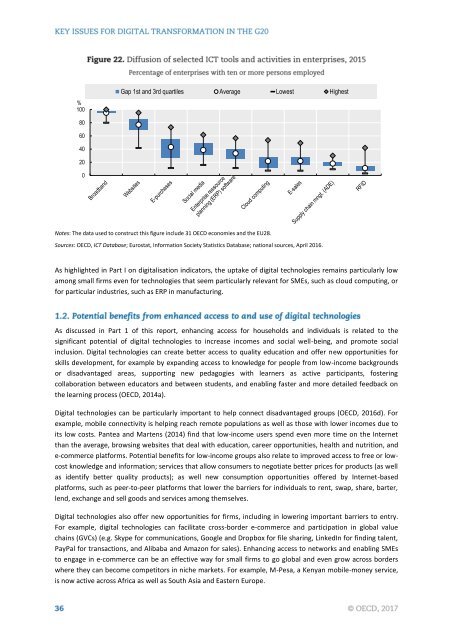KEY ISSUES FOR DIGITAL TRANSFORMATION IN THE G20
2jz0oUm
2jz0oUm
Create successful ePaper yourself
Turn your PDF publications into a flip-book with our unique Google optimized e-Paper software.
%<br />
100<br />
Gap 1st and 3rd quartiles Average Lowest Highest<br />
80<br />
60<br />
40<br />
20<br />
0<br />
Notes: The data used to construct this figure include 31 OECD economies and the EU28.<br />
Sources: OECD, ICT Database; Eurostat, Information Society Statistics Database; national sources, April 2016.<br />
As highlighted in Part I on digitalisation indicators, the uptake of digital technologies remains particularly low<br />
among small firms even for technologies that seem particularly relevant for SMEs, such as cloud computing, or<br />
for particular industries, such as ERP in manufacturing.<br />
As discussed in Part 1 of this report, enhancing access for households and individuals is related to the<br />
significant potential of digital technologies to increase incomes and social well-being, and promote social<br />
inclusion. Digital technologies can create better access to quality education and offer new opportunities for<br />
skills development, for example by expanding access to knowledge for people from low-income backgrounds<br />
or disadvantaged areas, supporting new pedagogies with learners as active participants, fostering<br />
collaboration between educators and between students, and enabling faster and more detailed feedback on<br />
the learning process (OECD, 2014a).<br />
Digital technologies can be particularly important to help connect disadvantaged groups (OECD, 2016d). For<br />
example, mobile connectivity is helping reach remote populations as well as those with lower incomes due to<br />
its low costs. Pantea and Martens (2014) find that low-income users spend even more time on the Internet<br />
than the average, browsing websites that deal with education, career opportunities, health and nutrition, and<br />
e-commerce platforms. Potential benefits for low-income groups also relate to improved access to free or lowcost<br />
knowledge and information; services that allow consumers to negotiate better prices for products (as well<br />
as identify better quality products); as well new consumption opportunities offered by Internet-based<br />
platforms, such as peer-to-peer platforms that lower the barriers for individuals to rent, swap, share, barter,<br />
lend, exchange and sell goods and services among themselves.<br />
Digital technologies also offer new opportunities for firms, including in lowering important barriers to entry.<br />
For example, digital technologies can facilitate cross-border e-commerce and participation in global value<br />
chains (GVCs) (e.g. Skype for communications, Google and Dropbox for file sharing, LinkedIn for finding talent,<br />
PayPal for transactions, and Alibaba and Amazon for sales). Enhancing access to networks and enabling SMEs<br />
to engage in e-commerce can be an effective way for small firms to go global and even grow across borders<br />
where they can become competitors in niche markets. For example, M-Pesa, a Kenyan mobile-money service,<br />
is now active across Africa as well as South Asia and Eastern Europe.


